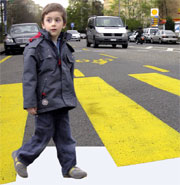 (ISO: Geneva, Switzerland) -- Head injuries are among the most common injuries sustained in automobile-to-child pedestrian collisions, and are the leading cause of death. The International Organization for Standardization is working to reduce the risk with an international standard for simulating the head-impact conditions of a child sustained in an actual accident/collision.
(ISO: Geneva, Switzerland) -- Head injuries are among the most common injuries sustained in automobile-to-child pedestrian collisions, and are the leading cause of death. The International Organization for Standardization is working to reduce the risk with an international standard for simulating the head-impact conditions of a child sustained in an actual accident/collision.
The new standard provides a crash test method for simulating the front impact of a vehicle to a child pedestrian’s head. The reconstruction results will allow manufacturers to generate estimates of head-impact conditions—such as impact velocity, angle, and timing—sustained in the simulated accident and, therefore, maximize harmonization of test results conducted by different test organizations.
…
Add new comment